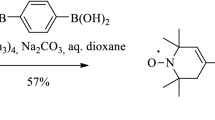Abstract
A theory of weak exchange interactions in biradicals is developed. The basic idea is to describe the motion of two weakly bound electrons on paramagnetic centers by a two-particle Schröbinger equation that takes into account the interaction of these electrons with the closed electron shells of the biradical, described by a model local potential, and their mutual Coulomb repulsion. The model potential can be constructed using the pseudopotential method, based on results of ab initio quantum chemical calculations. The exchange interaction between the unpaired electrons on the paramagnetic centers is calculated by a generalized asymptotic method that takes into account the quasi-classical nature of the subbarrier motion of the electrons in the region between the paramagnetic centers. The developed theory makes it possible to estimate the magnitude of the exchange interaction and to determine how this interaction depends on the distance between the paramagnetic centers and their relative orientation.
Similar content being viewed by others
References
V. N. Parmon, A. I. Kokorin, and G. M. Zhidomirov, Stable Biradicals (Nauka, Moscow, 1980) [in Russian].
V. A. Tran, K. Rasmussen, G. Grampp, and A. I. Kokorin, Appl. Magn. Reson. 32, 395 (2007).
Distance Measurements in Biological Systems by EPR, Ed. by L. J. Berliner, G. R. Eaton, and S. S. N. Y. Eaton (Kluwer Academic, Plenum, New York, 2000).
A. I. Kokorin, Appl. Magn. Reson. 26, 253 (2004).
K. Higashiguchi, K. Yumoto, and K. Matsuda, Org. Lett. 12, 5284 (2010).
E. A. Weiss, M. J. Ahrens, L. E. Sinks, et al., J. Am. Chem. Soc. 126, 5577 (2004).
W. Wang, S. Wang, X. Li, et al., J. Am. Chem. Soc. 132, 8774 (2010).
E. Pardo, J. Faus, M. Julve, et al., J. Am. Chem. Soc. 125, 10770 (2003).
S. A. Wolf, D. D. Awschalom, R. A. Buhrman, et al., Science 294, 1488 (2001).
E. Coronado, F. Palacios, and J. Veciana, Ang. Chem. Int. Ed. 42, 2570 (2003).
V. Mereacre, M. Nakano, J. Gómez, et al., Chem. Eur. J. 12, 9238 (2006).
S. Sanvito and A. R. Rocha, J. Comput. Theor. Nanosci. 3, 624 (2006).
EPR of Free Radicals in Solids II: Trends in Methods and Applications, Ed. by A. Lund and M. Shiotani (Springer, Dordrecht, Heidelberg, New York, London, 2013).
P. A. M. Dirac, The Principles of Quantum Mechanics (Clarendon, Oxford, 1958; Nauka, Moscow, 1979).
M. Diatkina and J. Syrkin, Acta Physicochim. U.R.S.S. 25, 23 (1946).
H. S. Jarrett, G. J. Sloan, and W. R. Vaughan, J. Chem. Phys. 25, 697 (1956).
J. Grafenstein, E. Kraka, M. Filatov, and D. Cremer, Int. J. Mol. Sci. 3, 360 (2002).
I. P. R. Moreira and F. Illas, Phys. Chem. Chem. Phys. 8, 1645 (2006).
O. Kwon and G.-S. Chung, Bull. Korean Chem. Soc. 29, 2140 (2008).
S. Nishizawa, J. Hasegawa, and K. Matsuda, Chem. Phys. Lett. 555, 187 (2013).
H. M. McConnel, J. Chem. Phys. 33, 115 (1960).
S. Ya. Umanskiy, E. N. Golubeva, and B. N. Plakhutin, Russ. Chem. Bull. 62, 1511 (2013).
E. E. Nikitin and S. Ya. Umanskiy, Theory of Slow Atomic Collisions (Springer, Berlin, Heidelberg, 1984).
J. D. Weeks, A. Hazi, and S. A. Rice, Adv. Chem. Phys. 16, 283 (1969).
P. Giannozzi, http://www.fisica.uniud.it/~giannozz
D. H. Pereira, A. F. Ramos, N. H. Morgon, and R. Custodio, J. Chem. Phys. 135, 034106 (2011).
A Primer in Density-Functional Theory, Ed. by C. Fiolhais, F. Nogueira, and M. A. L. Marques, Lecture Notes in Physics, Vol. 620 (Springer, Berlin, 2003).
M. A. Kozhushner and G. K. Ivanov, Chem. Phys. 170, 303 (1993).
M. A. Kozhushner, K. Ya. Burshtein, G. K. Ivanov, and V. S. Posvyanskii, J. Exp. Theor. Phys. 82, 32 (1996).
L. P. Gor’kov and L. P. Pitaevskii, Sov. Phys. Dokl. 8, 788 (1963).
C. Herring and M. Flicker, Phys. Rev. A 134, 362 (1964).
B. M. Smirnov and M. I. Chibisov, Sov. Phys. JETP 21, 624 (1965).
S. Ya. Umanskii and A. I. Voronin, Theor. Chim. Acta 12, 166 (1968).
O. Bouty, G. Hadinger, and M. Aubert-Frecon, J. Mol. Struct. 330, 97 (1995).
Author information
Authors and Affiliations
Corresponding author
Additional information
Original Russian Text © S.Ya. Umanskii, 2015, published in Khimicheskaya Fizika, 2015, Vol. 34, No. 1, pp. 3–10.
Rights and permissions
About this article
Cite this article
Umanskii, S.Y. Weak exchange interactions in biradicals: A pseudopotential for unpaired electrons and an asymptotic methods for calculating the exchange integral. Russ. J. Phys. Chem. B 9, 1–8 (2015). https://doi.org/10.1134/S1990793115010121
Received:
Published:
Issue Date:
DOI: https://doi.org/10.1134/S1990793115010121




